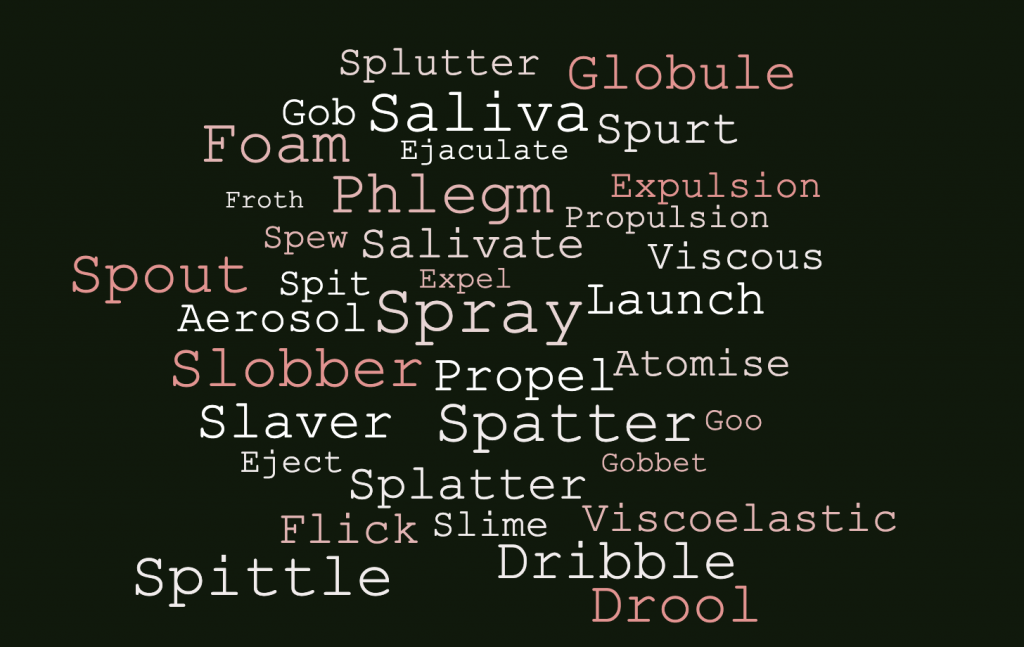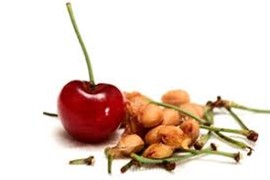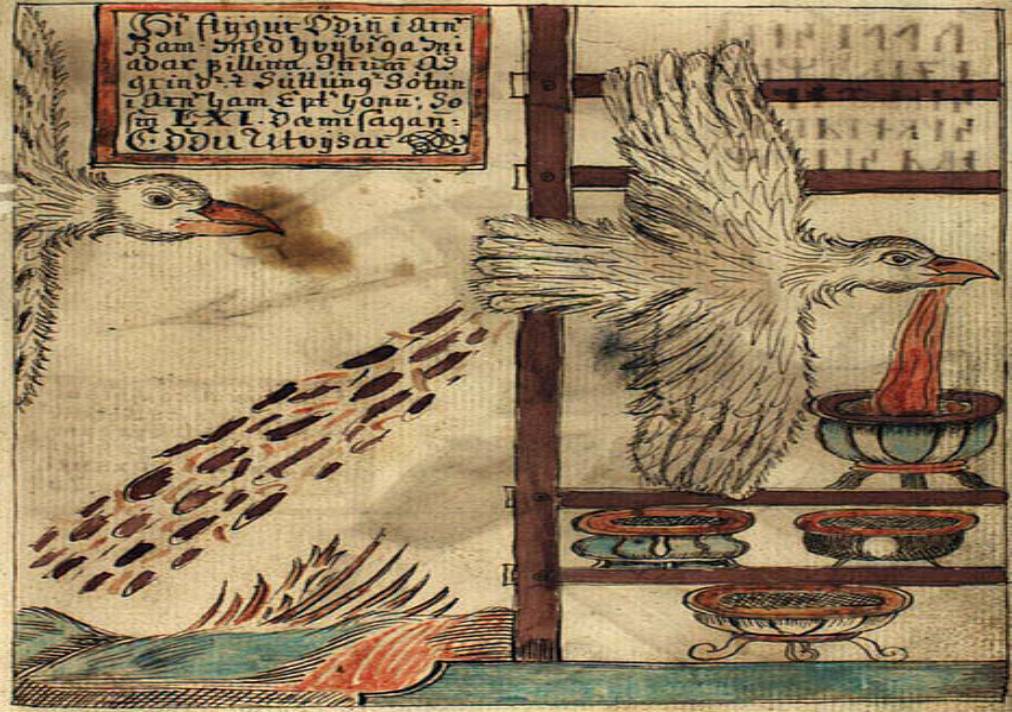The Vocabulary of Spit

Introduction
On 18th January 1980, my 21 year old self handed a £3.00 ticket to the security guards at the Caird Hall in Dundee. It was to see The Clash. I was working as a lowly assistant stage manager at the Dundee Rep theatre and feeling very cut off from my West London punk and reggae roots. For me this event was like going to church. Everyone in the queue was being frisked and the guards found a quarter bottle of vodka in my pocket. They were obliged to confiscate it, so I asked if I could have a quick swig. They said, yes, so I unscrewed the lid, downed the lot and handed them back an empty bottle. I wasn’t going to miss the gig for anything.
The way we worshipped in this church was by spitting. The band strode onto the stage and was greeted by a gleeful storm of spit. They got through two furious songs – Clash City Rockers and Brand New Cadillac and then the whole gig juddered to a halt. There was a long, green, viscoelastic strand of gob hanging from Mick Jones’ guitar. Joe Strummer desperately pleaded with us to stop spitting – so we did. The band launched another number and were immediately covered in a fresh wall of spit. The band stopped angrily and once more Joe begged for the spitting to stop – it was winter… it was unhealthy… the band would get sick… The concert restarted and this time anyone spitting near the front of the stage knew that they did so at risk of being kicked. The band were serious – and someone did get kicked – so the spitting resolved itself into occasional pogo-launched spurts at irresistible moments of ecstatic joy…
How did spitting become an act of worship?
*****
One of the most satisfying traditional tales I tell is called ‘The Grateful and the Dead’. It is my composite version of half a dozen recombined international variants of ATU 505 – The Grateful Dead.
In the Norwegian version of the story, the protagonist comes across a heap of ice lying outside a cold northern church, someone spits on it and the spit freezes, another person does the same and then another – until the protagonist realises that the whole pile of ice is in fact a pile of frozen spit. He discovers that it covers the corpse of a man, so hated, reviled and spat upon that, for 200 years, no-one has paid for him to be buried. The protagonist has a good conscience and senses this is a wrong that needs to be righted. He settles the dead man’s debts and pays for him to be interred with the full rites of respect. A little later, the protagonist meets a stranger who offers to become his guide and companion, and they seal the terms of service with a spit handshake… The first instance of spitting in the tale is a curse, but in the second case, the spitting turns out to mark a blessing.
What is going on? It seems spit can mark both sacrality and profanity…
I thought it would be fun to tease some meaning from this puzzle.
In another wide-spread, global tale, a man rescues a young snake from a fire; but in return the young snake coils itself around the rescuer’s throat and refuses to let go until the rescuer accepts to go where it leads him. The snake guides the man into a cave – to meet the great grandmother of all snakes. The rescued snake tells the man that he will be given a reward for his deed but advises him to spurn all riches and just ask for what is in the snake’s mouth… The great grandmother of all snakes offers the man vast quantities of precious stones, diamonds and gold. The man refuses everything and keeps asking for what’s in her mouth, finally the snake grandmother tells the man to open his mouth – and she spits into it. She then makes him promise never to reveal his secret to another human, or else he’ll die. ‘What secret?’ asks the man. ‘Go outside and you’ll find out…’ says the snake. Once he’s free the man discovers he can understand the language of all the birds, the beasts and all living creatures…

Producing Spit
Salivary Glands
Humans produce between one and five cups of saliva every day – almost all of it is swallowed. 99% of spit is water. The remaining 1% of saliva contains digestive enzymes, uric acid, electrolytes, mucus-forming proteins, and cholesterol. The different compounds found in saliva help break down the food in your mouth, help you to swallow it, and clean your teeth afterwards.
Spit is produced by a number of different salivary glands, all of which terminate in the mouth. There are 4 pairs of major salivary glands and about 1,000 minor ones.
The largest of the salivary glands are the two parotid glands which wrap around the rear of the lower jaw (mandibular ramus), one on each side. They produce 20% of the total salivary content in the oral cavity. They secrete saliva into the upper mouth to facilitate mastication and swallowing, and secrete amylase to begin the digestion of starches.
The submandibular glands are another pair of major salivary glands located beneath the lower jaws. Though they are much smaller than the parotid glands they produce a further 70% of the saliva in the oral cavity. The secretion produced is a mixture of both fluid and mucus, and enters the sides of the oral cavity from below via the submandibular duct.
The sublingual glands are a pair of major salivary glands located under the tongue, further back in the mouth than the submandibular glands. The secretion they produce is mainly mucous in nature. Unlike the other two major glands, the sublingual glands lack channelling ducts so saliva exits directly from between 8 and 20 excretory ducts. 5% of the saliva entering the oral cavity comes from these glands.
Von Ebner’s glands are serous hydrolising salivary glands which are found in the moats at the back of the last third of the tongue. They secrete lingual lipase which acts as a solvent in which solid particles of food substances can dissolve and be flushed towards the taste buds in order to enter them through oral mucosa located on the tongue.
There are a further 800 – 1,000 minor salivary glands located throughout the oral cavity that ensure everything is coated with saliva.
Uses of Saliva
Oral hygiene
Saliva is beneficial for the oral cavity and health in general. Saliva consist of proteins and is generally mixed with mucins – the principal organic constituents of mucus, the slimy viscoelastic material that coats all mucosal surfaces.
Saliva lubricates and protect both the soft and hard tissues of the oral cavity.
It protects the teeth, in general, the higher the saliva flow rate, the faster the clearance of harmful microbes and the higher the buffer capacity against them, hence better protection from dental decay. Saliva also forms a protective film on the surface of the tooth to prevent wearing. The film contains mucins and proline-rich glycoprotein. The proteins within the salivary pellicle inhibit demineralisation and promote remineralisation by attracting calcium ions.
The Antimicrobial power of Saliva
Saliva has an antimicrobial action and can prevent microbial growth based on the elements it contains. For example, lactoferrin in saliva binds naturally with iron. Since iron is a major component of bacterial cell walls, removal of iron breaks down the cell wall, which in turn breaks down the bacterium. Antimicrobial peptides such as histatins inhibit the growth of such things as Candida albicans (oral thrush) and Streptococcus mutans which causes tooth decay.
Licking wounds
Due to this antimicrobial capacity, Saliva can encourage soft-tissue repair by decreasing clotting time and increasing wound contraction. This is why animals lick their wounds – however it is possible for a wound to be overlicked and there are potential health hazards in wound licking due to infection risk. This is especially hazardous for immunocompromised patients. Human saliva contains a wide variety of bacteria that are harmless when in the mouth, but which may cause significant infection if introduced into a wound.
Saliva as a digestive aid
Saliva contains amylase, which hydrolyses starch into glucose, maltose, and dextrin. As a result, saliva allows some digestion to begin before the food reaches the stomach. Some of the swallowed saliva is deactivated by acid present in the stomach, however other enzymes that are present in it become activated by stomach acid.
Fear and a dry mouth
High stress or anxiety switches your body into fight, flight or freeze mode. When your body senses stress or danger it affects saliva production because the digestive system tries to do everything in its power to conserve energy, and that includes shutting down the production of spit. If you’re feeling stressed, scared, or anxious, you might notice that your mouth feels dry.
Salivary glands in other creatures
In some other organisms such as certain insects, salivary glands are also used to produce biologically necessary proteins such as silk or glues.
Spit Games
You can share the joys of the innumerable ancestors by playing competitive games of long distance spitting – pips, peas, rabbit dung – in fact anything small round and hard.

The world record for long distance cherry stone spitting is: 28.5metres
The Mythology of Spit
Cassandra, daughter of King Priam of Troy, sought the gift of prophecy from Apollo, but refused his sexual advances… Though he was rejected, he told her he would nonetheless give her the gift she sought, and spat in her mouth… Only to add afterwards that, though she would now always indeed speak the truth, she was also cursed that no one would ever believe her…
In the Coming of Age stories of Taliesin, Fionn MacCumhaill and Sigurd, spitting fish fat or boiling potion imbued those spat upon with poetic foresight: the knowledge of everything that is, was and will be… And with it a means of communicating it, sometimes with lyric clarity, at other times coded, by neccesity, in ‘the language of the birds…’
In Norse mythology, after the cosmic battle between the new upstart Gods, the Aesir and the old Gods, the Vanir, there was a ritual act of peace making. During the ceremony, all the assembled deities spat into a fermentation vat, and, in this way, created a concentrated magical liquid which contained the very essence of every manifestation of divine nature… This sacred spittle was then used to moisten the clay from which a man of high degree and knowledge was constructed. This being was then set down on earth to wander amongst humankind sharing the wisdom of the Gods, solving problems, soothing sorrows and leaving a trail of peace and reconciliation in his wake… BUT, inevitably, he whose purpose was to stop blood from being shed, was murdered by those withered by their greed… His body was bled dry and his blood mixed with honey. This was brewed into a mead of inspiration that gave all those who drank it the power of poetic utterance – and it was sold for profit. This was something which everyone thirsted for, and so fought to own and control. A long and viscious story follows, full of further theft, murder and deceit, but eventually, Odin, the All-Seeing, All-Knowing, Father of the Gods, (disguised as an Eagle,) manages to swallow all the mead and through a further act of spitting, return it safely to the cofines of his Divine circle – however a portion got farted out, and the aerosol droplets of Odin’s fart are the source of every bad poem you’ve ever heard…

Magic and Ritual
Spit as a curse
I spit on your mother’s grave
Yorkshire tradition has it that if you meet a white horse, you must spit, or ill luck will befall you.
Spit for Good Luck
Spit on the first money you receive in your day’s trading, and you will be lucky in the rest of the day’s business…
Say it! Don’t spray it!
The unintentional spitting or release of small saliva droplets or aerosols also happens during speech, particularly when articulating implosive consonants such as: ɓ ɗ ʄ ɠ ʛ – and ejective Consonants of which there are so many they have accrued beautiful descriptive terminologies such as: bilabial, labio-dental, linguo-dental, palatal, affricative, fricative, trilled, nasal, etc
…That said it can also happen intentionally when swearing oaths or saying prayers… Because the spit is sacralised.
And this seems to be the rub of it: Spit is the physical medium through which sacred intentionality has been expressed. It is sonically infused, residual evidence, and charged with magical and sacred properties that carry spirit… Every culture will have a term for such spirit, for example ‘Mana’ in Polynesian culture, or ‘Orenda’ in Iroquois culture, or ‘Blessing’ in the English language. All manner of charm workers, healers, magicians, walkers, shamans, priests, on every continent, can be seen creating cures, protections (and their opposite) through ritualised combinations of chanting, murmuring, muttering, and then, spitting.
* * * * * *
What did Dr.Frankenstein say when his monster spat on him?
IT’S SALIVA!
